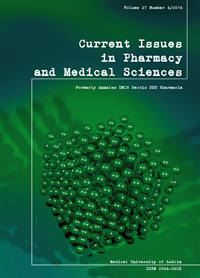The heparan sulfate and its diverse biological activities
DOI:
https://doi.org/10.1515/cipms-2015-0016Keywords:
heparan sulfate, glycosaminoglycans, proteoglycans, atherosclerosis, lipoproteinsAbstract
Heparan sulfate (HS) is one of the most common glycosaminoglycan (GAG) in mammals. It is composed of relatively simple disaccharide subunits, which, by further modification, such as sulfation and epimerization, potentially offer huge diversity in biological function. GAG chains of different length, different patterns of sulfation, and other modifications, depending on location, generate unique forms. Due to polyanion charges, these compounds can interact with other molecules, such as proteins, cytokines, chemokines and growth factors, both on the cell surface and inside the extracellular matrix. These interactions serve protective and storage functions for the compounds, safeguarding them from proteolysis. In this way, HS is involved in numerous signaling pathways, and in growth and differentiation processes. Disrupted interactions between the HS and growth factors, cytokines or other proteins have been observed in various disorders, among these Alzheimer’s disease, epilepsy, atherosclerosis, diabetes, and cancer processes. Detailed knowledge of these relationships at the molecular level will allow researchers to understand the mechanisms underlying these disorders and enable the development of effective therapeutic strategies.
References
1. Bishop J. R., Schuksz M., Esko J.D.: Heparan sulphate proteoglycans fine-tune mammalian in physiology. Nature, 446, 1030, 2007.
2. Dallinga G.M. et al.: The metabolism of triglyceride-rich lipoproteins revisited: New players, new insight. Atherosclerosis, 211, 1-8, 2010.
3. De Muro P. et al.: Urinary glycosaminoglycans composition in chronic glomerulonephritis. J Nephrol., 18, 154-160, 2005.
4. Fogelstrand P., Boren J.: Retention of atherogenic lipoproteins in the artery wall and its role in atherogenesis. Nutrition, metabolism & Cardiovascular Diseases, 22, 1-7, 2012.
5. Hosono-Fukao T. et al.: Heparan Sulfate subdomains that are degraded by sulf accumulate in cerebral amyloid β plaques of Alzheimer’s disease. Am J Pathol., 180, 2056-2067, 2012.
6. Jefferson A., Shankland S.J., Pichler R.H.: Proteinuria in diabetic kidney disease: A mechanistic viewpoint. Kidney International, 74, 22-36, 2008.
7. Kirn-Safran C., Farach-Carson M.C., Carson D. D.: Multifunctionality of extracellular and cell surface heparan sulfate proteoglycans. Cell. Mol. Life Sci., 66, 3421-3434, 2009.
8. Kolset S.O., Salmivirta M.: Cell surface heparan sulfate proteoglycans and lipoprotein metabolism. Cellular and molecular life sciences, 56, 857, 1999.
9. Lähdesmäki K. et al.: Acidity and lipolysis by group V secreted phospholipase A(2) strongly increase the binding of apoB-100-containing lipoproteins to human aortic proteoglycans. Biochim Biophys Acta, 1821, 257, 2012.
10. Madonna R., De Caterina R.: Potential roles of vessel wall heparan sulfate proteoglycans in atherosclerosis. Vascular Pharmacology, 62, 3, 120-122, 2014.
11. Malavaki Ch. J. et al.: Heparan sulfate: biological significance, tools for biochemical analysis and structural characterization. Biomed. Chromatogr., 25, 11, 2011.
12. Miner J. H.: The Glomerular Basement Membrane. Exp Cell Res., 318(9): 973-978, 2012.
13. Nakashima Y., Wight T.N., Sueishi K.: Early atheroslcerosis in humas: role of diffuse intimal thickening and extracellular matrix proteoglycans. Cardiovascular research, 79, 14, 2008.
14. Reitsma S. et al.: The endothelial glycocalyx: composition, functions, and visualization. Pflugers Arch-Eur J Phisiol, 454, 345-359, 2007.
15. Sarrazin S., Lamanna W. C., Esko J.D.: Heparan Sulfate Proteoglycans. Cold Spring Harb Perspect Biol., 3;a004952, 2011.
16. Segev A., Nili N., Strauss B.H.: The role of perlecan in arterial injury and angiogenesis. Cardiovascular Research, 63, 603, 2004.
17. Swarup V. P. et al.: Sugar glues for broken neurons. BiolMolecular Concepts, 4, 3, 233-257, 2013.
18. Tannock L. R., King V. L.: Proteoglycan mediated lipoprotein retention: A mechanism of diabetic atherosclerosis. Reviews in Endocrine & Metabolic Disorders, 9, 289, 2008.
19. Tarbell J. M. Tarbell: Shear stress and the endothelial transport barrier, Cardiovasc Res., 87, 320, 2010.
20. van den Berg B. M., Spaan J. A., Vink H.: Impaired glycocalyx barrier properties contribute to enhanced intimal low-density lipoprotein accumulation at the caroid artery bifurcation in mice. Pflugers Arch – Eur J Physil., 457: 1199-1206, 2009.
21. Zaferani A. et al.: Heparin/heparan sulphate interactions with complement – a possible target for reduction of renal function loss? Nephrol Dial Transplant, 0: 1-9, 2013.
Downloads
Published
Issue
Section
License
Copyright (c) 2015 Authors

This work is licensed under a Creative Commons Attribution-NonCommercial-NoDerivatives 3.0 Unported License.


